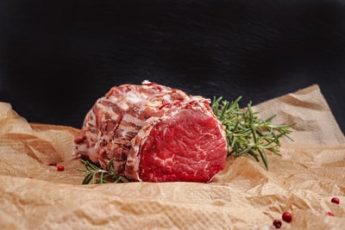The main purpose of a meat thermometer is to determine the internal temperature of meat. Meats continue to cook after they are removed from the heat source, so if you want to make sure that you are not overcooking the meat, you need to stop cooking it before it’s done. The cooking time will depend on the temperature and the size of the meat. Generally, larger meats need twenty minutes to cook, while thin cuts may need only a minute. It’s also important to rest meat, as it will redistribute the juices. This way, when you slice the meat, you will have meat that is tender and juicy.
Bimetallic thermometers are cheaper than thermocouples
| Image | Price | Buy | Prime | Title |
|---|---|---|---|---|
Top | Buy Now | PrimeEligible | MEATER Plus | Smart Meat Thermometer with Bluetooth | 165ft Wireless Range | for The Oven, Grill, Kitchen, BBQ, Smoker, Rotisserie | |
 Top
Top | Buy Now | PrimeEligible | Original MEATER | Smart Meat Thermometer | 33ft Wireless Range | for The Oven, Grill, Kitchen, BBQ, Rotisserie | |
 Top
Top | Buy Now | PrimeEligible | FVVL Meat Thermometer with Wireless, Bluetooth Meat Thermometer for The Oven, Grill, Kitchen, BBQ, Smoker, Rotisserie, Smart Meat Thermometer Digital with APP(No Registration, Wireless 165ft Range) | |
 Top
Top | Buy Now | PrimeEligible | ThermoPro Wireless Meat Thermometer of 500FT, Bluetooth Meat Thermometer for Smoker Oven, Grill Thermometer with Dual Probes, Smart Rechargeable BBQ Thermometer for Cooking Turkey Fish Beef | |
 Top
Top | Buy Now | PrimeEligible | ThermoPro TP829 Wireless Meat Thermometer for Grilling and Smoking, 1000FT Grill Thermometer for Outside Grill with 4 Meat Probes, BBQ Thermometer for Smoker Oven Cooking Beef Turkey | |
 Top
Top | Buy Now | PrimeEligible | GORNEL Digital Wireless Meat Thermometer – Cooking Thermometer with 2 Probes – 300Ft Remote Range Food Thermometer – IP65 Waterproof Probes – Preprogrammed Temperatures - Ideal for BBQ, Oven, Grill |
As an Amazon Associate we earn from qualifying purchases.
Bimetallic thermometers measure temperature in a variety of applications. They are commonly used in heating, air-conditioning, and refrigeration applications. They are inexpensive and easy to install. Many high-quality models have a dimple mark that indicates the proper depth for insertion.

These thermometers have a lower cost because they do not use mercury. In addition to being less expensive, they are also more accurate. However, bimetallic thermometers may not be as accurate as thermocouples. They cost approximately $50 to $100. If you are a serious meat eater, you should invest in a thermocouple thermometer.
Bimetallic meat thermometers use two wires of different metals welded together at the tip. The tip of these thermometers generates a small voltage, which is then calibrated. This voltage is then used to read the temperature of food. Type K thermocouples use chromium and nickel. They are usually used near the end of cooking.
Instant-read thermometers are more accurate
A meat thermometer is a device that measures the internal temperature of meat. The temperature is important for the texture, flavor, and safety of meat. Meat geeks want to make sure that their food is cooked to the exact temperature for optimum taste and texture. They must also ensure that the food is safe for consumption.
Instant-read meat thermometers are usually more accurate than their analog counterparts. However, they have their limitations. One of them is that they need 5-8 seconds to lock in. Another drawback is that they are more expensive than cheaper models. Besides, some thermometers don’t come with a 5-year warranty.
An instant-read thermometer works by sticking the probe into the meat. This probe is then removed after taking the temperature reading. On the other hand, a leave-in thermometer requires a longer time to read a meat’s internal temperature.
Digital probe thermometers can be used in the oven
Digital probe meat thermometers are ideal for the oven, where they can be placed inside the meat. The probe is attached to a long, oven-proof wire. The meat thermometer is then programmed to give a beep when the temperature is reached. A few meat thermometers even connect to your smartphone app.

These meat thermometers are available in various styles and price ranges. Some are simple, inexpensive dial types. Others are wireless or have a digital display. Dial thermometers are difficult to read, so you should opt for one with a digital display. Alternatively, you can purchase a thermometer with a touchscreen that you can use to check the temperature of the meat without opening the oven.
While analog thermometers are easy to read, they have a tendency to become uncalibrated. Digital thermometers are much faster at registering food temperatures. Additionally, digital models have other features that can make cooking easier. For instance, some models come with preset timers and backlit displays.
Infrared thermometers are not as accurate as general-use thermometers
Unlike general-use thermometers, infrared meat thermometers do not measure the internal temperature of a piece of meat. Instead, they use a method called infrared radiation. These are not as accurate as thermometers that measure surface temperature. They can be used for a variety of applications, such as assessing how cooked a steak is.

The maximum temperature range of infrared meat thermometers varies from a few hundred degrees to several thousand degrees Fahrenheit. The manufacturer usually states this information on their product to give consumers a general idea of their accuracy. This accuracy level is expressed as a plus-or-minus percentage. A thermometer that is accurate to two percent of the stated temperature can be considered very accurate. However, the accuracy level should not be too high.
Common IR thermometers are not as accurate as general thermometers. This is because they are calibrated over a wide temperature range and may be one degree off the accurate range of human body temperature. However, if you are going to use an IR meat thermometer for cooking or monitoring meat, you should choose a device that is certified by a competent agency and under the direction of a certified professional.











